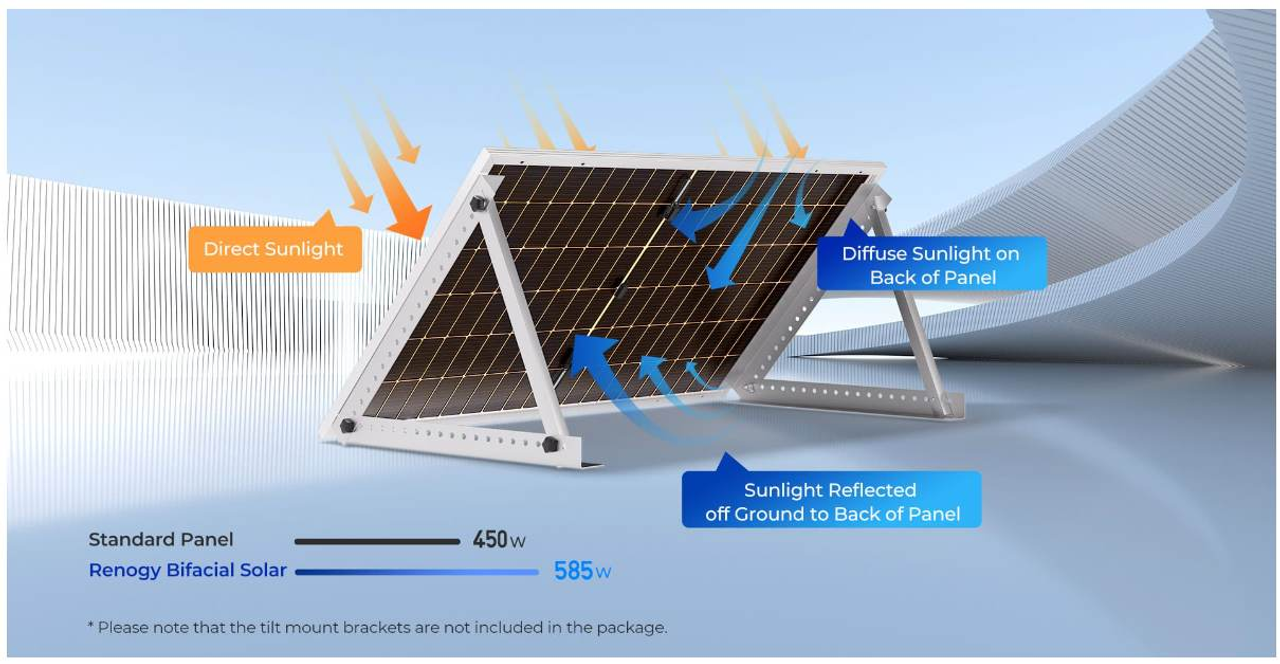Renogy's Latest Bifacial Panel Line-Up
The trajectory of solar panel technology continues to increase each and every year. This might have some consumers waiting to jump into the market until the next big improvement comes around. The problem is that you’re likely to keep waiting as each wave of successive improvements hits the market. Of course no one wants to be in a situation where you’d scrap older panels before they’ve reached their effective lifetime, but waiting too long for the latest tech might have you listening to a noisy gas-powered generator far too long. Bifacial panels might be the efficiency improvement that you’ve been waiting for – and your solar powered boondocking neighbors will thank you for the gift of silence when you are parked next to them!
A few months ago we filmed a detailed video review of Renogy’s 220W Bifacial Solar Panel, which claims to be up to 30% more efficient than standard monofacial panels. We put it to the test in the real world conditions of the Chino Hills State Park campground. We found several conditions that added credence to this claim, including the flat roof-top installation that most RVers will opt for (though efficiency can be increased if you use a tilt-mount option for longer parking situations) as well as a partially-shaded situation while camping in and among trees.
Since we completed this review, Renogy has added several different options of bifacial panels in their line-up – some optimized for smaller solar array installations that are best suited for RVs or boats (115W or 220W), others better for houses or off-grid cabins (220W and 450W), and some would even work well in commercial installations (550W). See chart below for details.
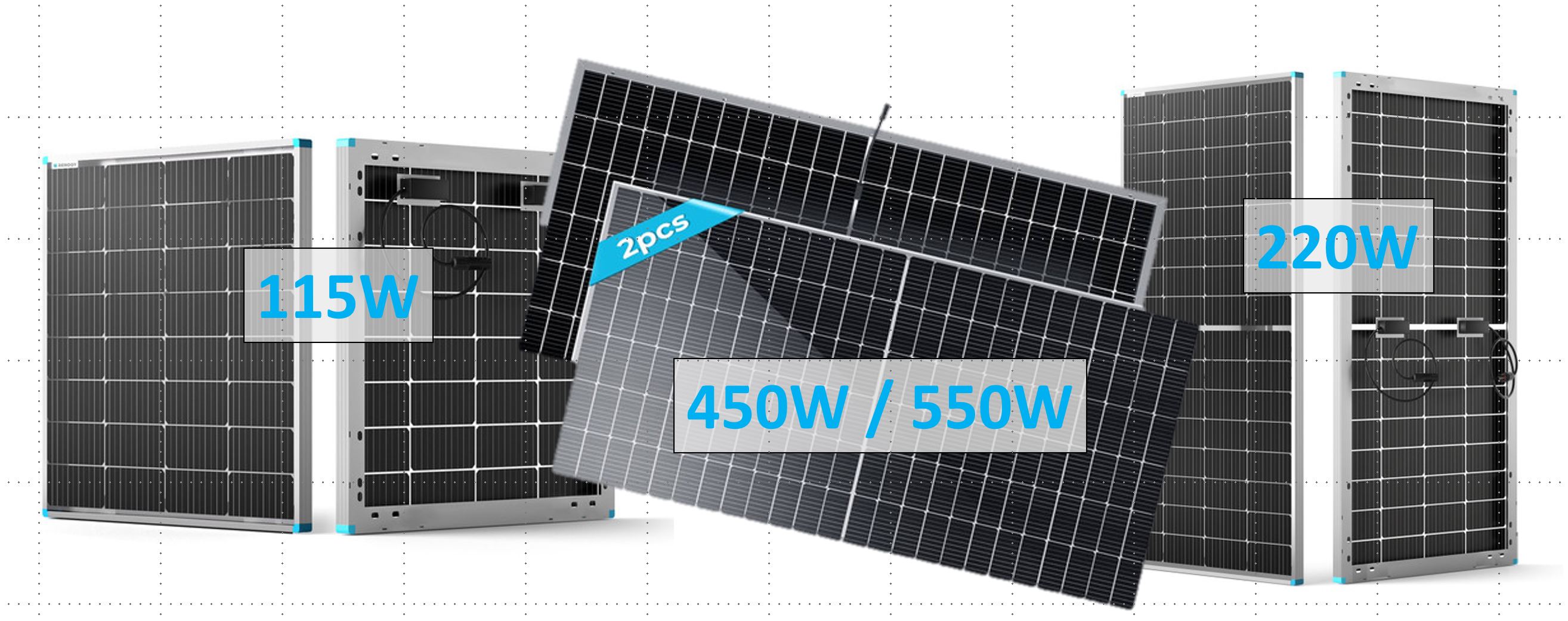
What’s the Difference between Monofacial and Bifacial Panels?
Most solar panels are solid white on one side and have solar cells on the other. With a bifacial panel, both sides of the panel are equipped with solar cells to capture more light, including the light which bounces off a reflective (or white surface) from the back side of the panel. Just think of the increased efficiency in sandy (≅11.8% increase) or snowy (≅24.6% increase) regions! Bifacial panels used in snowy environments can also cause snow to melt faster as they heat up from the back, melting the snow load on the front. To learn more about how these panels are constructed as well as the advantages and disadvantages of bifacial solar panels,check out this article.
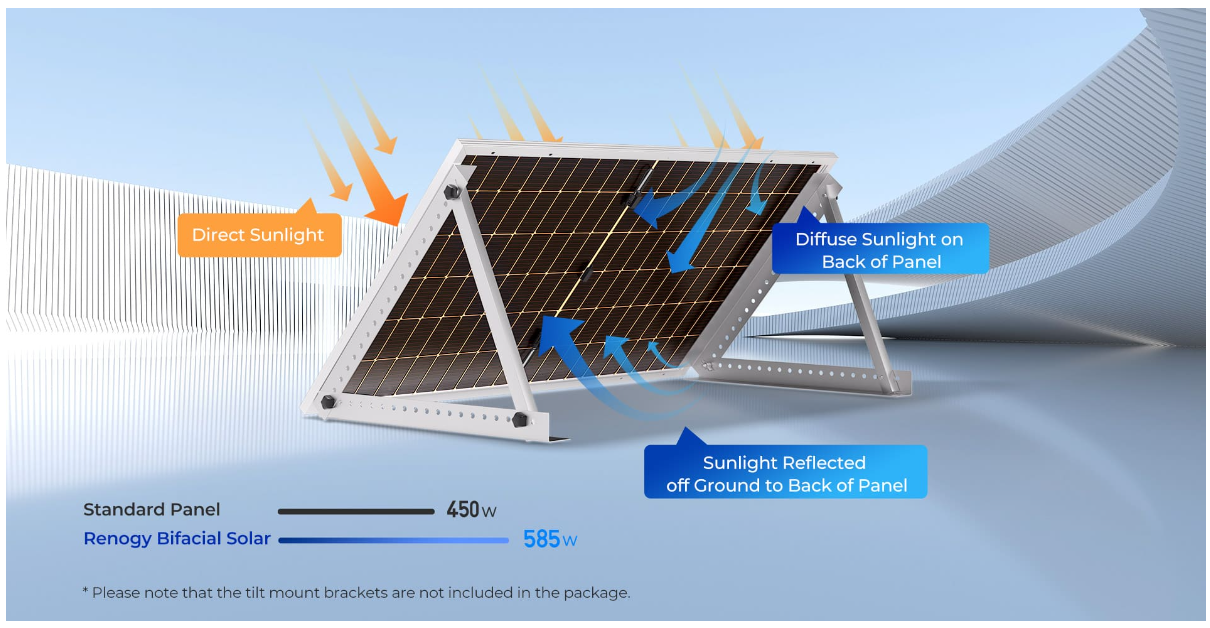
Bifacial Solar Panels vs Monocrystalline Solar Panels?
It’s important to not confuse the terms monofacial and monocrystalline. Monofacial refers to a panel with solar cells on only one side while monocrystalline refers to the way the cells themselves are constructed. Bifacial panels are typically made of monocrystalline cells, which are much more efficient than older polycrystalline cells. The term 'mono' means ‘single’, which tells us that the solar cells are manufactured from a single crystal with a uniform structure. This uniform structure consequently allows the electrons to move more freely throughout the cell and thus produce better power generation per unit area of the cell, which is the very definition of “efficiency” itself, right? Most monocrystalline solar panels offer 20% (or more) efficiency, which is significantly higher than their older polycrystalline counterparts. Overall, when comparing bifacial panels, make sure you purchase a monocrystalline version.
Can You Use Bifacial Panels on a Roof?
For homeowners, these new bifacial panels are an excellent choice for pergolas, sunrooms, patio covers, and those who have their panels on an elevated tilt-mount. If mounted on a roof, it’s important for the roof to be reflective (using a light-colored aluminum roofing material) rather than a dark color in order to get the most benefit from the bifacial nature of the panel. To further increase solar gain and efficiency, the panels should be permanently tilted or have the ability to be adjusted.
Can You Use Bifacial Panels on an RV Roof?
For RVs or vans, bifacial panels will work in a variety of applications from rooftops to side awnings to a portable ground panel, with tilt mount brackets being the name of the game for optimal efficiency. Since you aren’t always able to choose the most optimal way to park your rig within a campground that has designated spots, it’s helpful to have a panel which will generate power from both sides, thereby capturing as much sun as possible and generating the most energy without having to move your vehicle. And, for boat owners, the water will make the perfect reflective surface to augment your solar gain.
Renogy’s 2023 Bifacial Panel Line Up
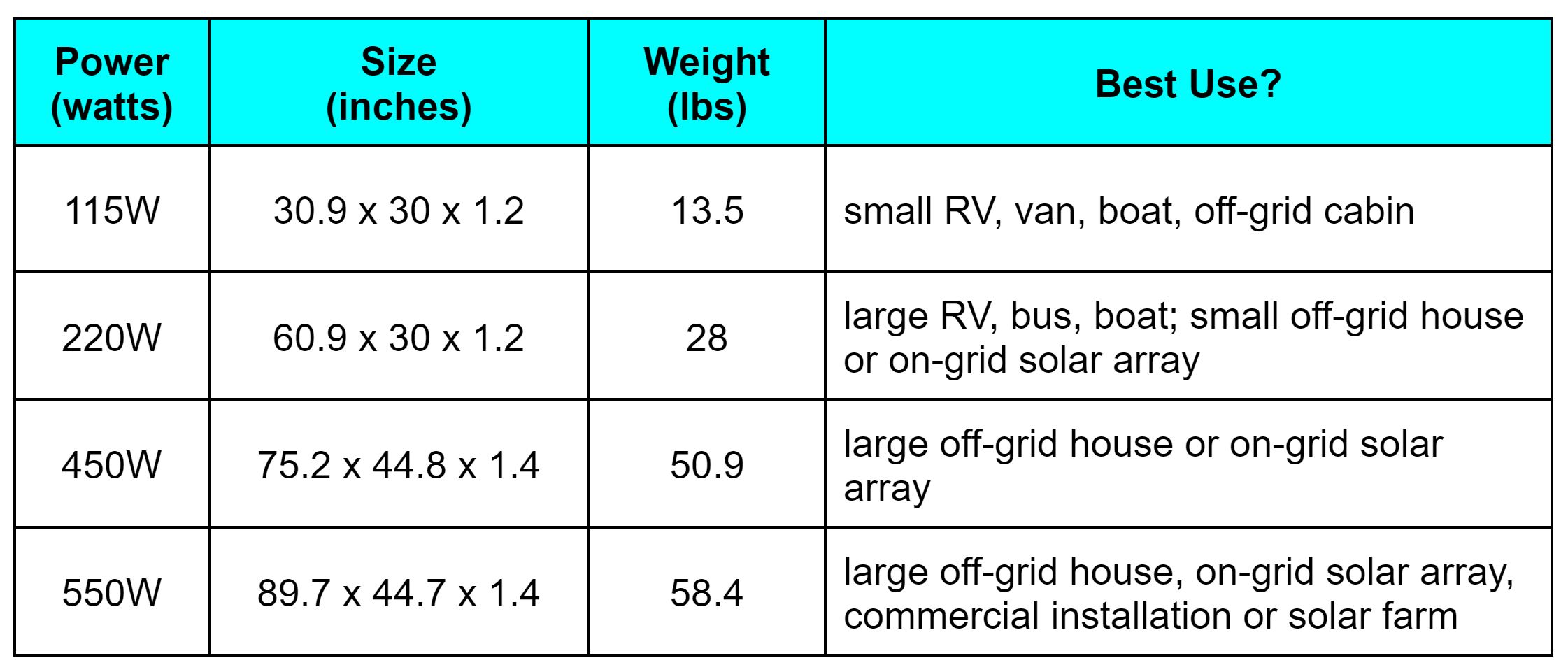
All of the bifacial panels in Renogy’s line up are constructed with the same key features including:
- Grade A+ Monocrystalline Solar Cells: Grade A solar panels are the best solar cells on the market. Curious about how solar panels are graded? Check out this article.
- Half-Cut 64 Cells: Half-cut solar cells increase both performance (lower current = less energy loss due to resistance within cells) and durability (smaller size = more resistant to cracking). This aspect of the bifacial panels makes them more effective and efficient when partially-shaded, as we’ve shown in our product review video.
- PERC Technology: PERC stands for Passivated Emitter and Rear Cell technology. Well that clears it up, right? It allows more photons to be captured by the silicon – each cell makes a little more electricity than previous technology. Want to nerd out a bit more? Here’s more info.
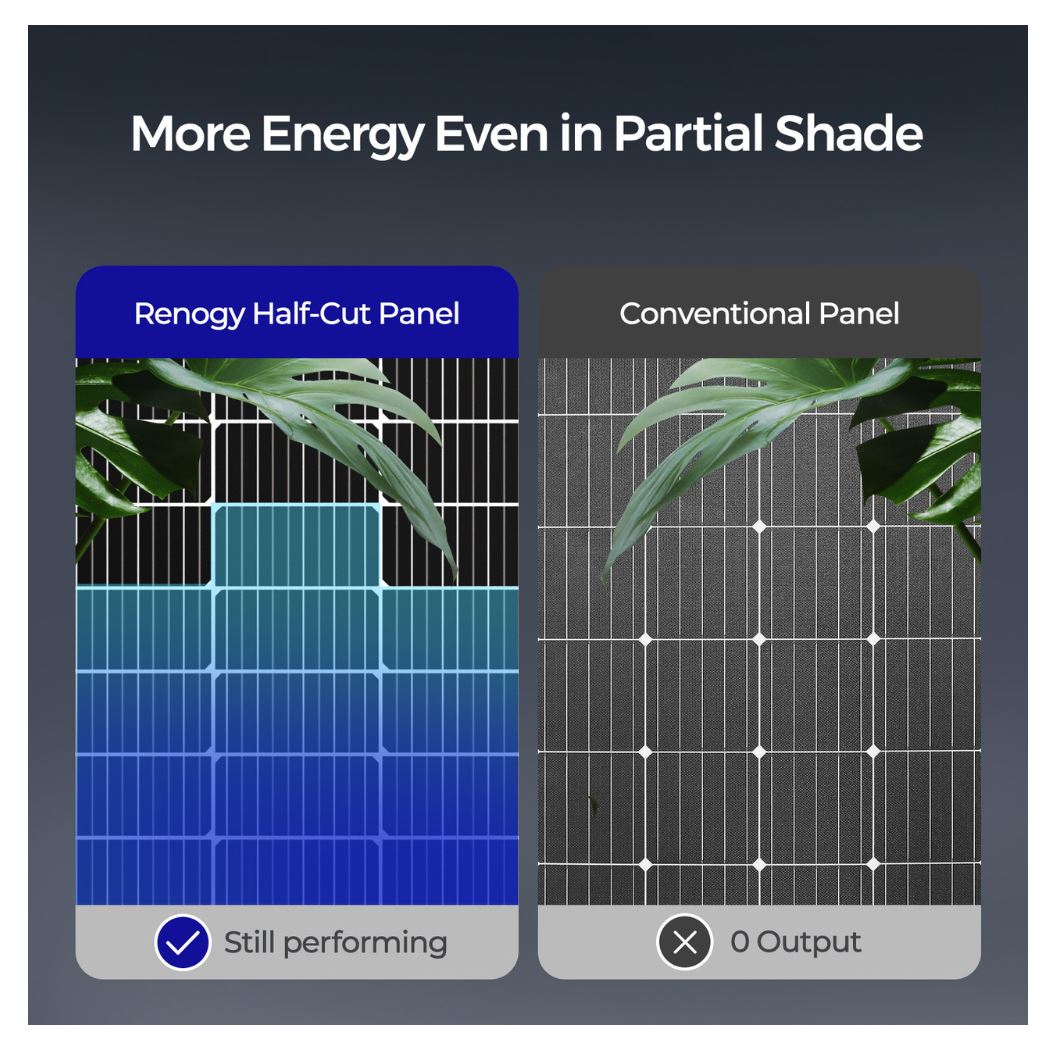
- 10 Bus Bars: Bus bars are solid metal bars used to carry current which are typically made from copper or aluminum. They are rigid, flat, and wider than cables, and can carry more current within the same cross-sectional area. Furthermore, the larger surface area of a bus bar dissipates heat more efficiently than a cable over its entire length. Using 10 bus bars increases overall efficiency within the solar panel itself.
- Bypass Diode Network: Bypass diodes are connected in parallel with a series of solar cells, all within a module or a panel. These little diodes allow current to bypass a cell that is shaded, faulty, or covered with debris, thus preventing it from becoming a hotspot that can overheat and degrade the module.
How Efficient Are Bifacial Solar Panels?
We performed our test and detailed our results in an earlier blog, but we wanted to quickly revisit our findings here. Here are our 3 key take-aways:
1. Flat Panel Orientation
The bifacial panel is more versatile and performs better in the types of conditions that most RVer’s and boat owners are likely to face in real world conditions. In our results, the 220W bifacial panel produced a higher percentage of power than the monofacial panel, even in a flat orientation.
2. Partially-Shaded Conditions
Due to its enhanced internal cell structure and design, the bifacial panel outshines its monofacial cousin significantly in partially-shaded conditions caused by trees, rooftop AC units, power lines, buildings, etc.
3. Low Angle & Non-Optimal Orientation
If you are going to park your RV or boat for a while (or plan to install bifacial panels in a more permanent situation), use tilt mounts for greater efficiency as they will help you take advantage of that lower sun angle earlier in the morning and later in the evening (as well as during the fall, winter, and spring). Overall, they can produce more power than the monofacial, single-sided panel when not facing the sun directly.
So, the big question… are bifacial solar panels worth it? We sure think so! And, if you use them with the best possible reflective surface, they can greatly increase the efficiency of your overall system.

In 2012, Shari Galiardi & David Hutchison left behind careers and a comfortable home in North Carolina to travel with the vintage camper trailer they lovingly restored, outfitted with solar, and named "Hamlet." What began as a short break from careers and responsibility quickly turned into a love affair with roadlife. They have parlayed their higher education backgrounds, desire for life-long learning, and thirst for adventure travel into writing, photography, video production, and public speaking gigs from coast to coast. Known to their friends as simply Shari & Hutch, you can learn more about their full-time, solar-powered adventures on their website at freedominacan.com. Or, follow them on Facebook, Instagram, and YouTube as “Freedom in a Can, LLC.”

